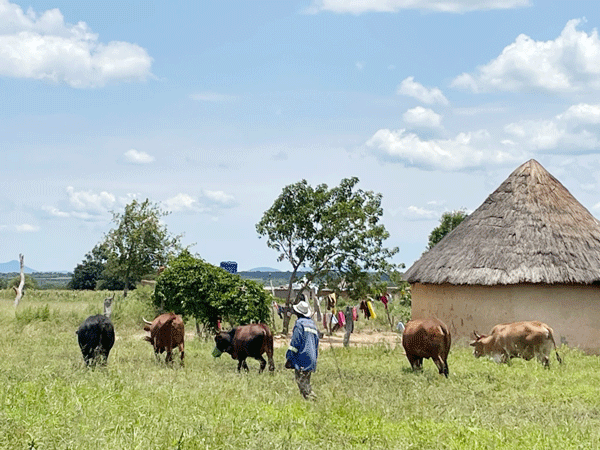
BY Ian Scoones There is a huge government and aid machinery to respond to drought in Zimbabwe. Humanitarian relief, cash plus transfer schemes, shock-responsive aid, anticipatory action, insurance products, climate-smart development and much, much more, with millions of dollars spent. But what is drought, and how are different responses framed?
For some, drought is just a deficit in rainfall across a season — this is a meteorological framing, which mostly drives the formal responses, and assumes that drought is a defined risk, an event that can be easily understood, resulting in particular interventions (usually some combination of the list above).
But for others including farmers — drought is much more complex, with interacting and highly context-specific causes, diverse outcomes and impacts on livelihoods. This requires a much more attuned, flexible response, embracing this complexity.
Multiple causes of drought
A few weeks back, we were visiting our sites across Masvingo province from Chikombedzi in the far south to Gutu, Chatsworth further north and asked about drought. It was a topical conversation as the season (yet again) had been a strange one, with very uneven rainfall even if the totals were relatively high. This has made it very difficult to manage the season, with the stop start rainfall. Everyone was hoping for some more rains, as the maize was wilting in the fields after a good start. Since then, some have been lucky, others not and there will be no crop to speak of.
Across our field sites everyone was, therefore, talking of nzara. This translates from Shona as drought, but it is different from the meteorological definition; it is more about the consequences, hunger. This is important, as there are many causes to the outcome of nzara, and this is what we ended up discussing.
Yes, lack of rainfall is important but as people repeatedly emphasised, it is not the seasonal average but when and where rain falls within the season, as well as how effective it is. Does it simply run off from capped soils or does it soak in? Rainfall for crop growth is very different on heavy clay soils as against sandy soils, and also different in valleys and on the uplands. The interaction between rainfall and agronomy, soils, topography and management of land is very specific, and one place (even one part of a farm) can be very different from another. This is why farmers universally rejected weather forecasts as being of any use, as conditions are so variable.

- Chamisa under fire over US$120K donation
- Mavhunga puts DeMbare into Chibuku quarterfinals
- Pension funds bet on Cabora Bassa oilfields
- Councils defy govt fire tender directive
Keep Reading
But even if rain falls, farmers explained, there are a range of factors that influence crop production. With the same rain, one farmer can succeed, while others fail. Many referred to planning, being ready for eventualities and being able to adapt.
This requires skill, intelligence and, above all, flexible labour and draught power. Others argued (always about others!) that some farmers were simply “lazy”, they did not care about their fields, were always at beer parties and did not attend to their farms. Some failed because they were old, without help, or ill or infirm. These social, health and psychological factors contribute to what the effects of drought might be, they argued.
Material assets are important too. Those with draught power of their own can plough early and catch the rains; those with tractors are even better off especially in the larger land areas of the new resettlements. Those by contrast who have to hire or borrow or worse dig by hand were unable to respond to rainfall events so effectively. The same applies to fertilizer — those able to purchase fertilizer (now ridiculously expensive) or with access to manure, were able to achieve better yields, even with the same land and labour. Access to inputs of different sorts, therefore, is crucial in confronting drought.

The pattern of farming makes a difference too. The small-scale Pfumvudza plots that many have invested in backed by the government and NGOs as part of drought relief and climate-smart agriculture have become an important part of the agricultural system of late.
In the resettlement areas, these essentially garden plots are farmed intensively by hand and yield well, but provide in total only small amounts, while the extensive outfields need a different type of investment. Only if you have both can you provide enough food for sale and consumption and avoid nzara, our informants explained.
Adapting to uncertain contexts
As we discussed many years ago in the book, hazards and opportunities: Farming livelihoods in dryland Africa, in the aftermath of the major 1991-92 drought, all of these factors biophysical, social, material and more determine who wins and loses in a drought. In some instances, lack of rainfall wipes out everything for everyone (what some call a co-variate shock), but this is rare, as there is usually a much more variegated outcome.
There are in the jargon more idiosyncratic effects, with quite specific outcomes.
This is important, as the simplistic responses from the State and aid machinery often miss their mark, and why they have to be adapted to uncertain contexts, as we explained in a recent paper. This is why understanding how responses are mobilised by different people in different places is essential. This is the focus of the next blog in this short series.
- This story first appeared on Zimbabweland











